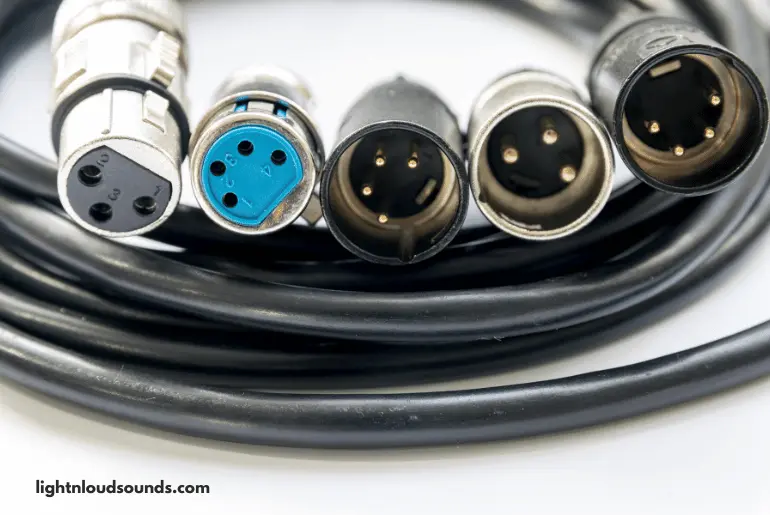Exploring the practicality of utilizing XLR microphone cables for powered speakers poses a relevant question to many audio enthusiasts and professionals. Essentially, an XLR cable is commonly used to transmit balanced audio signals between different audio equipment, including microphones and speakers.
The core inquiry here: is it suitable to use XLR microphone cables for connecting and transmitting audio to powered speakers, which already have a built-in amplifier? So, in this post, we’ll take a closer look at compatibility, signal integrity, and overall audio performance when employing such cables in a powered speaker setup.
Post Contents
Can You Use XLR Microphone Cable for Powered Speakers?
Yes, you can use XLR microphone cables for powered speakers, especially considering that powered speakers often come equipped with balanced XLR input jacks suitable for such connections. Powered speakers, distinct due to their internal amplifiers and speaker wiring, are categorized as line-level devices and are thus compatible with standard, balanced XLR microphone cables.
Numerous powered speakers provide a balanced XLR input jack, and some even feature an additional unbalanced 1/4-inch jack, allowing direct connections for guitars, keyboards, and other line-level gear using shielded, unbalanced cables. However, it’s imperative to avoid using unshielded speaker cables with powered speakers as they can yield undesirable audible humming and radio interference noise due to the absence of proper shielding.
Although the usage of XLR microphone cables is generally suitable for powered speakers, always ensure that the specific connections and settings align with the equipment’s requirements to safeguard against potential damage and to uphold optimal audio quality.
What Cables Do I Need for Powered Speakers?
1. XLR Cables
XLR cables are quite popular for connecting powered speakers, especially in professional audio setups. The cable consists of three wires: hot, cold, and ground, and is designed to transmit balanced audio signals, minimizing the interference and noise over longer distances.
Powered speakers frequently feature XLR input jacks due to their ability to handle balanced audio signals, which is crucial for maintaining sound quality in various environments, such as live events and studio recordings. Moreover, XLR cables are durable and lock into place, preventing accidental disconnections.
2. TS and TRS Cables
TS (Tip-Sleeve) and TRS (Tip-Ring-Sleeve) cables are also viable options for connecting powered speakers. A TS cable is unbalanced and generally used for mono audio signals or as a musical instrument cable.
On the other hand, TRS cables can be used for transmitting balanced audio signals, similar to XLR cables, but are often utilized in different contexts like connecting headphones or linking audio interfaces. Some powered speakers have 1/4-inch TS or TRS input jacks, making these cables suitable for various applications, such as compact sound systems and home studios.
3. RCA Cables

RCA cables are commonly used in consumer audio and home theater setups. They transmit unbalanced audio signals and are often utilized to connect CD players, turntables, or other home audio devices to powered speakers.
In some instances, powered speakers come with RCA input jacks to accommodate such connections, providing flexibility for users to integrate various audio sources. However, due to their unbalanced nature, RCA cables are more susceptible to interference over longer distances compared to balanced cables like XLR or TRS.
4. Speakon Cables
Speakon cables are specifically designed for transmitting high-power audio signals and are widely used in live sound applications. These cables ensure a secure and safe connection due to their locking mechanism, minimizing the risk of accidental disconnection while in use.
Some powered speakers, particularly those used in professional and live sound environments, may feature Speakon connectors due to their reliability and ability to handle high power levels without risking damage to the cable or connectors.
5. Optical and Coaxial Cables
For powered speakers used in home theaters or personal audio systems, digital cables like optical and coaxial might be relevant. Optical cables transmit audio signals as light pulses, providing isolation from electrical interference, while coaxial cables use an electrical signal.
Some high-end powered speakers might have digital input options, offering a direct digital connection from source devices like TVs, gaming consoles, or Blu-ray players, ensuring a pure, unaltered digital signal path.
FAQ
Do XLR cables carry power?
Yes, XLR cables can carry power along with audio signals in certain circumstances, a configuration commonly known as “phantom power.” This is frequently utilized in the world of professional audio to provide power to condenser microphones, which require an external power source to function. Phantom power is typically supplied by audio interfaces, mixers, or dedicated external power supply units and is sent via the same XLR cable that carries the audio signal from the microphone to the connected device.
Conclusion
After delving into the facets of using XLR microphone cables with powered speakers, it’s clear that while the cable can physically connect the devices, the assurance of optimal audio quality and signal preservation hinges on various factors like cable quality, length, and the specific equipment used. Ensuring that the XLR cables are capable of preserving the integrity of the audio signal between the source and the powered speakers is paramount.
Therefore, while feasible, audio professionals and enthusiasts should approach this setup with a meticulous ear, guaranteeing that the desired audio output and performance are achieved without compromising the involved equipment.

